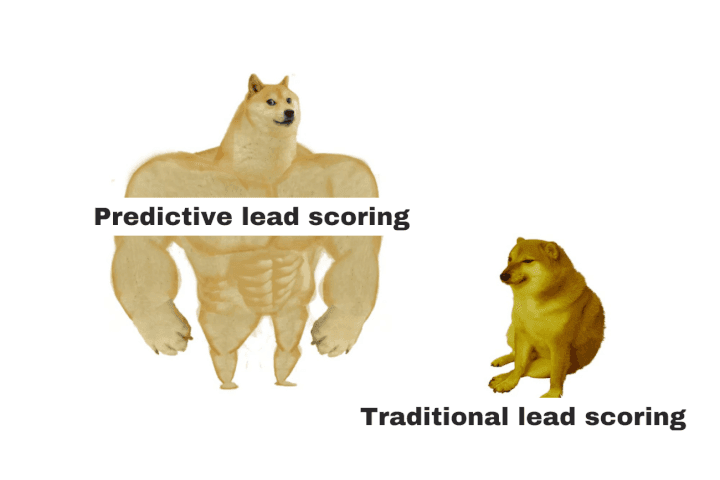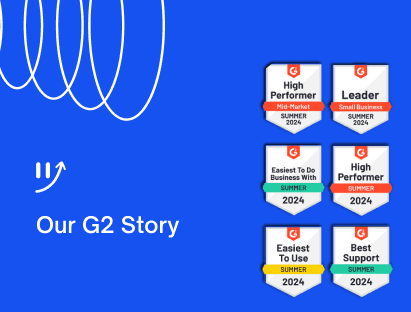5 Lead Scoring Models To Level Up Your Sales
5 Lead Scoring Models To Level Up Your Sales
5 Lead Scoring Models To Level Up Your Sales
Discover five types of lead scoring models and best scoring practices. Additionally, learn about an awesome tool that can help you effectively score and convert leads.
Discover five types of lead scoring models and best scoring practices. Additionally, learn about an awesome tool that can help you effectively score and convert leads.
Discover five types of lead scoring models and best scoring practices. Additionally, learn about an awesome tool that can help you effectively score and convert leads.



Want to identify the hottest leads?
We have the solution for you — lead scoring models.
And by models, we don’t mean…

… But it’s just as fabulous.
Why?
A lead scoring model assigns a lead a score based on numerous factors uniquely tailored to fit your business goals. 🧵
But which lead scoring model should you go for?
The answer depends on what your business objectives are.
In this article, we’ll look at five helpful lead scoring models and five best practices to improve lead scoring.
We’ll also highlight the only tool you need to score and convert leads like a pro.
Let’s go!
Five Helpful Lead Scoring Models
What’s that sound?
It’s five beautiful lead scoring models strutting down the catwalk! 👠
But we think you’d prefer being a trendsetter than a follower 😎. If you agree, jump here to find the ultimate headless sales software that will change your life.
While you’re at it, explore these five lead scoring models that can help you identify money-making leads:
1. Demographic Model
You’re not looking for just any lead.
You’re looking for the Cinderella to your Prince Charming. 😍
Demographic models help your sales team identify which leads fit into the ideal customer profile and which need fairy godmother-level pampering. ✨
This lead scoring process uses demographic information such as gender, age, job title, or income. Both demographic and firmographic data are known as explicit scoring. However, demographic data is more useful for B2C companies, whereas B2B tends to focus on firmographic data (more on this later).
Leads usually provide demographic information by filling out landing page forms.
Let’s say your target audience includes CEOs, VPs, and other executives. You can assign a higher score to a hot lead in such positions than a mid-level associate or intern.
To get that fairy tale ending, sometimes you need to give a negative lead score to leads who aren’t quite the right fit. This involves subtracting points from their overall lead score to differentiate them from your ideal customer.
That’s how you’ll know who’s the belle of the ball and whose foot isn’t a match!

2. Online Behavior Model
This lead scoring strategy helps online and e-commerce businesses determine a hot lead depending on how they interact with your content or website. The score you give to certain user actions depends on what has the highest value to your company.
For instance, online behavioral scoring may involve e-commerce companies assigning a higher point value to leads downloading their app more. In contrast, online media companies may consider a data point like longer page interactions more valuable.
An online lead scoring system can derive behavioral data from what folks in the biz call implicit scoring.
It scores leads based on actions like:
Number of pages visited
Visit frequency
Number of sessions spent on the company app
In-app clicks and interactions
Signing up for email subscriptions
Following social media profiles
Downloading offers
Length of time spent on pages
And let’s face it, some pages are more important than others, so you should give a higher score to users for interacting with them.
If a user visits your pricing page often and at length, that’s worth a higher lead score. You’ll know it’s time for some kaching kaching! 💰
Psst! Some tools even specialize in recognizing patterns from the in-app behavior of users…
3. B2B Scoring Model
B2B scoring models help narrow down the most valuable leads for B2B companies. This scoring system uses explicit scoring to assign a point value based on firmographic data like:
Work titles
Industry
Departments
Company sizes
Business types
While this may sound similar to a demographic scoring model, the main difference is that demographic data segments individual consumers. B2B lead scoring models typically target organizations.
You won't just take note of a lead's profession but also their role and status within the organization. For instance, you could rank a vice president higher than an HR manager, as a VP will have more purchasing authority.
That’s what we call fashion forward 😎.
4. Engagement Models
It’s time for the big question. 💍
What’s an engagement model?
This scoring system helps organizations gauge interest through a lead’s interactions with your brand’s digital marketing activities.
Let’s go over the two main types of engagement models:
A. Email Engagement
An email lead scoring system analyzes lead interactions with your email marketing campaigns.
It lets you see how effective email marketing efforts are in lead generation. It also helps monitor the following:
Open rates and click-throughs
Leads who scroll to the bottom
Number of people who haven’t engaged
You can give a higher lead score to those who click through high-value emails, like demo offers.
Is it getting hot in here?
You’re feeling the white-hot, lead-seeking precision of an email lead scoring model. 🔥
B. Social Media Engagement
Who’s getting social with your brand?
Find out by assigning scores to certain activities on your social media channels, such as:
Liking posts
Retweeting
Sharing
Commenting
5. Negative Scoring Model
Is your lead sales ready?

Bummer.
In the negative scoring model, you subtract points from a lead score based on actions or characteristics suggesting a fading or complete lack of interest.
For example:
Working in the wrong industry
Having too small a company
Unsubscribing from email lists
Browsing your career page
Submitting invalid contact numbers
Stick with us as we’re about to explain the positives!
With the guidance of a negative scoring model, you won’t have to waste time on stagnant leads that aren’t moving through your sales funnel.
Wanna know a fun fact?
You can use negative scoring with any scoring model! Whether it’s B2B, online behavior, or email engagement — point deductions from a lead score help identify a sales ready lead more easily. It’s a handy way to make your sales team more efficient.
Now, read on for tips to make your chosen scoring model effective.
Five Best Practices To Improve Lead Scoring
1. Use More Than One Score
Suppose your target buyer persona is local companies.
In that case, a simple demographic-based lead scoring system may work if your priority is to focus on a lead’s region.
But as your company scales and your audience broadens, you’ll quickly find this isn’t one of the best practices.
For example, let’s say Lead A is in their 20s. They may interact with your social media marketing more often than Lead B, who is in their 50s. As a result, younger leads score higher on the engagement level criteria you’ve set up.
Does this mean Lead B isn’t as good a prospect as Lead A?
It’s unlikely — especially if your product is expensive.
This is why you need to take multiple scores into account.
It prevents one score from unfairly skewing results and presenting an inaccurate picture of who’s worth pursuing.
Here’s another example of two models working together:
B2B lead scoring can help you spot small or mid-market businesses that suit your buyer persona. At the same time, you can also use negative lead scoring to narrow down your list — for example, if you want to avoid going after businesses with turnovers of less than $500,000.
2. Decide How To Assess Sales-Qualified Leads
A prospect becomes a sales-qualified lead (SQL) after being effectively nurtured by the marketing team and showing an intent to buy.
To define your criteria for an SQL, you’ll want to consider:
Factors contributing to lead conversion.
Indications that it’s better to disqualify leads, such as those who are unsure about what the decision-making process at their company entails.
The value of certain actions and characteristics (e.g. new leads visiting your site’s homepage shouldn’t rank higher than leads contacting a sales rep about pricing).
Assessing SQLs accelerates the sales cycle and prevents a sales rep from wasting time on anyone who isn’t a sales ready lead (yet!).
3. Integrate With CRM Tools For Better Lead Insights
While a marketing automation scoring system ranks a prospect’s behavior, your sales team will do most of their work in the company’s customer relationship management (CRM) database.
You should base your data flow from marketing automation and CRM software on automated alerts that can assign a sales ready lead to a specific sales rep. Then the sales qualifying discussions can begin and (hopefully) result in an opportunity!
Guess what – Toplyne is a super convenient way to sync leads with CRM apps!
4. Get Customer Feedback
Your sales team can’t always give you the whole story. Sometimes, you have to talk to customers to ensure you’re on the same page.
Get their feedback from surveys and interviews to understand what works best for them and what can be improved. This can help you widen your pool of leads and keep the business afloat. 🏊
Remember, customers from long AND short buying cycles are as different as a novel and a tweet.
Interviewing both will give you a better idea of why a prospect converts quickly or takes more time to decide.
5. Simplify Lead Qualification With Predictive Lead Scoring
Some companies use traditional lead scoring for lead qualification. But there’s one problem.
It’s 2023, folks! You shouldn’t have to manually assign point values.
Traditional lead scoring is too basic and rigid to survive in the fast-paced world of digital marketing. It’s like casually strolling through an Olympic race.
Software solutions are sprinting to the rescue with predictive lead scoring. 🏃
Predictive scoring is miles better than traditional lead scoring because it does the hard part for you. It uses historical data to automatically create a qualified lead profile — and even adapts to new information!
But predictive lead scoring alone isn’t enough.
One of the most vital lead scoring best practices is to select lead scoring software that works with your tech stack rather than requiring you to rework or replace it.
Luckily, there’s an innovative headless sales AI solution.
Want in?
We won’t leave you in the dark for long…
Shine A Spotlight On The Hottest Leads With Toplyne
Bring out your cameras! 📸
Ensure your sales team can see the big picture with Toplyne.
This unique tool removes the need for the complex data transfers often needed to accommodate scoring tools.
Create a sleek, efficient pipeline of product-qualified leads, increase win rates, identify conversion opportunities, AND boost net revenue retention (NRR).
Here’s how companies like Canva and Vercel generate sales pipeline from their self-serve funnel using Toplyne:
Step 1/7: Create monetization playbooks to surface conversion and expansion opportunities (leads most likely to convert to paying customers, and teams most likely to grow into larger teams)

Step 2/7: Choose the right leads to target – users (individual users) or accounts (a group of users with an organization).

Step 3/7: Select the frequency at which you would want leads synced in your GTM apps.

Step 4/7: Define how many leads you want by either the number of leads or your expected win rate, depending on your sales capacity and GTM strategy.

Step 5/7: Build custom segments - Build custom segments based on And/Or logic at the deepest level of sub-properties within your product analytics.

Step 6/7: Validate your GTM strategy - Hold back some users as a control group to test your GTM strategy.

Step 7/7: Sync your product qualified pipeline into your GTM destinations - CRMs, sales & marketing execution tools, and customer engagement platforms.

That’s right!
A smoother lead qualification pipeline means higher lead conversion rates. Capture the moment — and high win rates — to improve NRR.
Ready for a sample?
Lead Scoring Models: What’s On The Menu?
A good lead scoring model is like hot chocolate with extra whipped cream.
It’s nearly always a good idea — especially if you have plenty of leads and want to determine who’s worth your time.
There are multiple lead scoring models, and all can help you depending on your objective.
But want to know which powerful tool can help you flawlessly execute the lead scoring and qualification process AND hit your conversion targets?
Drumroll, please. 🥁
It’s Toplyne!
This one-of-a-kind tool brings everything together to execute a smooth lead conversion process.
See for yourself, try Toplyne for free today, and we bet it’s going to be like something you’ve never experienced before (like the first time you tried cheesecake?!).
![[optimize output image]](https://framerusercontent.com/images/vqOAzevLPKntpSjKprz2ktVvu8c.gif)
Want to identify the hottest leads?
We have the solution for you — lead scoring models.
And by models, we don’t mean…

… But it’s just as fabulous.
Why?
A lead scoring model assigns a lead a score based on numerous factors uniquely tailored to fit your business goals. 🧵
But which lead scoring model should you go for?
The answer depends on what your business objectives are.
In this article, we’ll look at five helpful lead scoring models and five best practices to improve lead scoring.
We’ll also highlight the only tool you need to score and convert leads like a pro.
Let’s go!
Five Helpful Lead Scoring Models
What’s that sound?
It’s five beautiful lead scoring models strutting down the catwalk! 👠
But we think you’d prefer being a trendsetter than a follower 😎. If you agree, jump here to find the ultimate headless sales software that will change your life.
While you’re at it, explore these five lead scoring models that can help you identify money-making leads:
1. Demographic Model
You’re not looking for just any lead.
You’re looking for the Cinderella to your Prince Charming. 😍
Demographic models help your sales team identify which leads fit into the ideal customer profile and which need fairy godmother-level pampering. ✨
This lead scoring process uses demographic information such as gender, age, job title, or income. Both demographic and firmographic data are known as explicit scoring. However, demographic data is more useful for B2C companies, whereas B2B tends to focus on firmographic data (more on this later).
Leads usually provide demographic information by filling out landing page forms.
Let’s say your target audience includes CEOs, VPs, and other executives. You can assign a higher score to a hot lead in such positions than a mid-level associate or intern.
To get that fairy tale ending, sometimes you need to give a negative lead score to leads who aren’t quite the right fit. This involves subtracting points from their overall lead score to differentiate them from your ideal customer.
That’s how you’ll know who’s the belle of the ball and whose foot isn’t a match!

2. Online Behavior Model
This lead scoring strategy helps online and e-commerce businesses determine a hot lead depending on how they interact with your content or website. The score you give to certain user actions depends on what has the highest value to your company.
For instance, online behavioral scoring may involve e-commerce companies assigning a higher point value to leads downloading their app more. In contrast, online media companies may consider a data point like longer page interactions more valuable.
An online lead scoring system can derive behavioral data from what folks in the biz call implicit scoring.
It scores leads based on actions like:
Number of pages visited
Visit frequency
Number of sessions spent on the company app
In-app clicks and interactions
Signing up for email subscriptions
Following social media profiles
Downloading offers
Length of time spent on pages
And let’s face it, some pages are more important than others, so you should give a higher score to users for interacting with them.
If a user visits your pricing page often and at length, that’s worth a higher lead score. You’ll know it’s time for some kaching kaching! 💰
Psst! Some tools even specialize in recognizing patterns from the in-app behavior of users…
3. B2B Scoring Model
B2B scoring models help narrow down the most valuable leads for B2B companies. This scoring system uses explicit scoring to assign a point value based on firmographic data like:
Work titles
Industry
Departments
Company sizes
Business types
While this may sound similar to a demographic scoring model, the main difference is that demographic data segments individual consumers. B2B lead scoring models typically target organizations.
You won't just take note of a lead's profession but also their role and status within the organization. For instance, you could rank a vice president higher than an HR manager, as a VP will have more purchasing authority.
That’s what we call fashion forward 😎.
4. Engagement Models
It’s time for the big question. 💍
What’s an engagement model?
This scoring system helps organizations gauge interest through a lead’s interactions with your brand’s digital marketing activities.
Let’s go over the two main types of engagement models:
A. Email Engagement
An email lead scoring system analyzes lead interactions with your email marketing campaigns.
It lets you see how effective email marketing efforts are in lead generation. It also helps monitor the following:
Open rates and click-throughs
Leads who scroll to the bottom
Number of people who haven’t engaged
You can give a higher lead score to those who click through high-value emails, like demo offers.
Is it getting hot in here?
You’re feeling the white-hot, lead-seeking precision of an email lead scoring model. 🔥
B. Social Media Engagement
Who’s getting social with your brand?
Find out by assigning scores to certain activities on your social media channels, such as:
Liking posts
Retweeting
Sharing
Commenting
5. Negative Scoring Model
Is your lead sales ready?

Bummer.
In the negative scoring model, you subtract points from a lead score based on actions or characteristics suggesting a fading or complete lack of interest.
For example:
Working in the wrong industry
Having too small a company
Unsubscribing from email lists
Browsing your career page
Submitting invalid contact numbers
Stick with us as we’re about to explain the positives!
With the guidance of a negative scoring model, you won’t have to waste time on stagnant leads that aren’t moving through your sales funnel.
Wanna know a fun fact?
You can use negative scoring with any scoring model! Whether it’s B2B, online behavior, or email engagement — point deductions from a lead score help identify a sales ready lead more easily. It’s a handy way to make your sales team more efficient.
Now, read on for tips to make your chosen scoring model effective.
Five Best Practices To Improve Lead Scoring
1. Use More Than One Score
Suppose your target buyer persona is local companies.
In that case, a simple demographic-based lead scoring system may work if your priority is to focus on a lead’s region.
But as your company scales and your audience broadens, you’ll quickly find this isn’t one of the best practices.
For example, let’s say Lead A is in their 20s. They may interact with your social media marketing more often than Lead B, who is in their 50s. As a result, younger leads score higher on the engagement level criteria you’ve set up.
Does this mean Lead B isn’t as good a prospect as Lead A?
It’s unlikely — especially if your product is expensive.
This is why you need to take multiple scores into account.
It prevents one score from unfairly skewing results and presenting an inaccurate picture of who’s worth pursuing.
Here’s another example of two models working together:
B2B lead scoring can help you spot small or mid-market businesses that suit your buyer persona. At the same time, you can also use negative lead scoring to narrow down your list — for example, if you want to avoid going after businesses with turnovers of less than $500,000.
2. Decide How To Assess Sales-Qualified Leads
A prospect becomes a sales-qualified lead (SQL) after being effectively nurtured by the marketing team and showing an intent to buy.
To define your criteria for an SQL, you’ll want to consider:
Factors contributing to lead conversion.
Indications that it’s better to disqualify leads, such as those who are unsure about what the decision-making process at their company entails.
The value of certain actions and characteristics (e.g. new leads visiting your site’s homepage shouldn’t rank higher than leads contacting a sales rep about pricing).
Assessing SQLs accelerates the sales cycle and prevents a sales rep from wasting time on anyone who isn’t a sales ready lead (yet!).
3. Integrate With CRM Tools For Better Lead Insights
While a marketing automation scoring system ranks a prospect’s behavior, your sales team will do most of their work in the company’s customer relationship management (CRM) database.
You should base your data flow from marketing automation and CRM software on automated alerts that can assign a sales ready lead to a specific sales rep. Then the sales qualifying discussions can begin and (hopefully) result in an opportunity!
Guess what – Toplyne is a super convenient way to sync leads with CRM apps!
4. Get Customer Feedback
Your sales team can’t always give you the whole story. Sometimes, you have to talk to customers to ensure you’re on the same page.
Get their feedback from surveys and interviews to understand what works best for them and what can be improved. This can help you widen your pool of leads and keep the business afloat. 🏊
Remember, customers from long AND short buying cycles are as different as a novel and a tweet.
Interviewing both will give you a better idea of why a prospect converts quickly or takes more time to decide.
5. Simplify Lead Qualification With Predictive Lead Scoring
Some companies use traditional lead scoring for lead qualification. But there’s one problem.
It’s 2023, folks! You shouldn’t have to manually assign point values.
Traditional lead scoring is too basic and rigid to survive in the fast-paced world of digital marketing. It’s like casually strolling through an Olympic race.
Software solutions are sprinting to the rescue with predictive lead scoring. 🏃
Predictive scoring is miles better than traditional lead scoring because it does the hard part for you. It uses historical data to automatically create a qualified lead profile — and even adapts to new information!
But predictive lead scoring alone isn’t enough.
One of the most vital lead scoring best practices is to select lead scoring software that works with your tech stack rather than requiring you to rework or replace it.
Luckily, there’s an innovative headless sales AI solution.
Want in?
We won’t leave you in the dark for long…
Shine A Spotlight On The Hottest Leads With Toplyne
Bring out your cameras! 📸
Ensure your sales team can see the big picture with Toplyne.
This unique tool removes the need for the complex data transfers often needed to accommodate scoring tools.
Create a sleek, efficient pipeline of product-qualified leads, increase win rates, identify conversion opportunities, AND boost net revenue retention (NRR).
Here’s how companies like Canva and Vercel generate sales pipeline from their self-serve funnel using Toplyne:
Step 1/7: Create monetization playbooks to surface conversion and expansion opportunities (leads most likely to convert to paying customers, and teams most likely to grow into larger teams)

Step 2/7: Choose the right leads to target – users (individual users) or accounts (a group of users with an organization).

Step 3/7: Select the frequency at which you would want leads synced in your GTM apps.

Step 4/7: Define how many leads you want by either the number of leads or your expected win rate, depending on your sales capacity and GTM strategy.

Step 5/7: Build custom segments - Build custom segments based on And/Or logic at the deepest level of sub-properties within your product analytics.

Step 6/7: Validate your GTM strategy - Hold back some users as a control group to test your GTM strategy.

Step 7/7: Sync your product qualified pipeline into your GTM destinations - CRMs, sales & marketing execution tools, and customer engagement platforms.

That’s right!
A smoother lead qualification pipeline means higher lead conversion rates. Capture the moment — and high win rates — to improve NRR.
Ready for a sample?
Lead Scoring Models: What’s On The Menu?
A good lead scoring model is like hot chocolate with extra whipped cream.
It’s nearly always a good idea — especially if you have plenty of leads and want to determine who’s worth your time.
There are multiple lead scoring models, and all can help you depending on your objective.
But want to know which powerful tool can help you flawlessly execute the lead scoring and qualification process AND hit your conversion targets?
Drumroll, please. 🥁
It’s Toplyne!
This one-of-a-kind tool brings everything together to execute a smooth lead conversion process.
See for yourself, try Toplyne for free today, and we bet it’s going to be like something you’ve never experienced before (like the first time you tried cheesecake?!).
![[optimize output image]](https://framerusercontent.com/images/vqOAzevLPKntpSjKprz2ktVvu8c.gif)
Related Articles




Behavioral Retargeting: A Game-Changer in the Cookieless Era
Unlock the power of behavioral retargeting for the cookieless future! Learn how it personalizes ads & boosts conversions. #behavioralretargeting




All of Toplyne's 40+ Badges in the G2 Spring Reports
Our customers awarded us 40+ badges in G2's Summer Report 2024.




Unlocking the Full Potential of Google PMax Campaigns: Mastering Audience Selection to Double Your ROAS
Copyright © Toplyne Labs PTE Ltd. 2024
Copyright © Toplyne Labs PTE Ltd. 2024
Copyright © Toplyne Labs PTE Ltd. 2024
Copyright © Toplyne Labs PTE Ltd. 2024